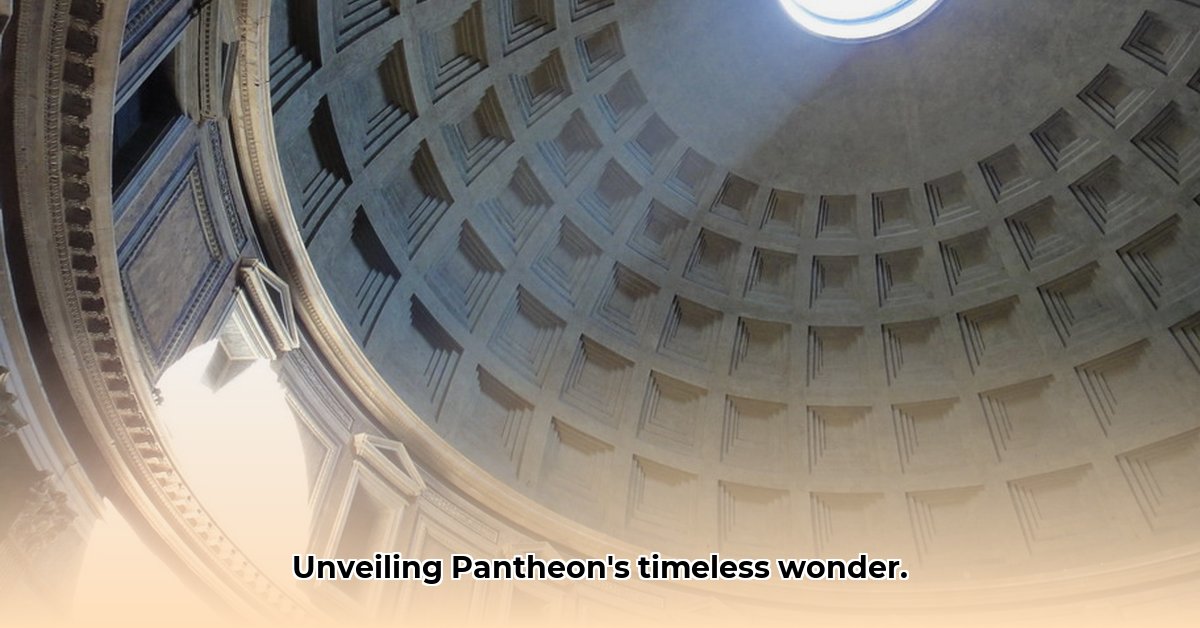
Pantheon: A Timeless Symbol of Roman Ingenuity
The Pantheon, often shortened to "the Pan," transcends its classification as a mere building; it stands as a profound testament to Roman engineering brilliance and a symbol of enduring cultural legacy. Its almost 2,000-year existence is a testament to exceptional construction, a history interwoven with religious shifts, and a powerful influence on architecture spanning millennia. This article delves into the Pan's remarkable story, exploring its architectural innovations, historical journey, and ongoing preservation challenges.
Architectural Brilliance: A Masterclass in Roman Concrete
The Pantheon's most striking feature is undoubtedly its massive dome, a feat of engineering unparalleled in its time. How did the Romans achieve this architectural marvel without modern tools? The answer lies in their mastery of opus caementicium—Roman concrete (a mixture of aggregate, lime, and volcanic ash). This wasn't simply a poured structure; it was a meticulously crafted layered system. Heavier, denser concrete formed the base, gradually lightening towards the apex, a technique that cleverly distributed the immense weight. This ingenious approach, combined with the interior coffering system (recessed panels that lessened the dome's overall weight), allowed for the creation of an unsupported dome of 142 feet in diameter – a truly awe-inspiring feat. Isn't it remarkable how such advanced techniques were employed nearly two millennia ago? A study of the Pantheon's concrete provides profound insights into Roman material science. The use of pozzolana, a volcanic ash, bestowed remarkable durability and strength upon the concrete.
The dome’s grandeur is seamlessly complemented by the imposing rectangular portico, supported by eight towering granite columns. This striking juxtaposition of circular and rectangular forms creates a visual harmony that’s both powerful and aesthetically pleasing. The single oculus, a large circular opening at the dome's apex, not only provides the building's sole natural light source but also creates a breathtaking interplay of light and shadow that shifts throughout the day, enhancing the Pantheon’s mystical ambiance. The Pantheon’s dimensions—its width equaling its height—further underline the Romans' understanding of balance and symmetry. These elements combine to make the building incredibly impressive in both its internal and external aesthetics.
A Historical Journey: From Pagan Temple to Modern Icon
Pinpointing the Pantheon's exact origins remains a subject of scholarly debate. While Emperor Hadrian is widely credited with completing the structure around 128 AD, evidence suggests earlier iterations may have existed, possibly dating as far back as the reign of Augustus. This is significant because it suggests a continuous evolution of design and construction. The building initially served as a temple dedicated to all the Roman gods, before undergoing a transformation into a Christian church in 609 AD. This adaptability highlights the building's enduring significance, transcending shifts in cultural and religious practices. How many structures can claim such a multifaceted history?
Throughout its long history, the Pantheon has endured numerous challenges. It has experienced alterations, restorations, and even the stripping away of its original bronze roof. The ongoing work of scholars to unravel the Pantheon's construction history reveals layers of its past; each discovery unveils new details about its construction and evolution. Their meticulous analysis helps to separate original Roman elements from later additions, creating a clearer picture of its development over centuries.
Enduring Influence: A Legacy in Stone
The Pantheon's impact on architecture is undeniable. Its majestic dome, symbolizing power and divinity, has served as an inspiration for countless structures throughout history, from the Renaissance period onwards. Many architectural marvels from across the world show the Pantheon’s influence, especially in the design of domes and the use of classical elements. The proportions, the use of the oculus to bring in light, and the incorporation of Greco-Roman architectural styles have all influenced generations of architects. Researchers continue to explore the Pantheon’s architectural influence, uncovering new layers of its impact on design.
Modern Challenges and Conservation: Preserving a Legacy
Today, the Pantheon faces the modern challenge of balancing its immense popularity – attracting millions of visitors annually – with the critical need for preservation. The sheer number of visitors requires careful management to protect the structure from damage while ensuring accessibility for all who wish to experience its awe-inspiring grandeur. Balancing the needs of conservation with the desires of the public is a constant challenge. What are the innovative solutions to this complex problem? Ongoing conservation efforts are crucial to ensure that this extraordinary monument continues to inspire awe for centuries to come.
Conclusion: A Symbol of Enduring Human Ingenuity
The Pantheon stands as a symbol of human creativity, resilience, and the enduring power of architectural innovation. Its long and complex history, architectural mastery, and lasting influence make it a true icon—a building that deserves continued preservation and study. It is a monument not only to the Roman Empire but also to the enduring spirit of human endeavor. The Pantheon is a testament to the power of vision and the ability of human ingenuity to create lasting structures both remarkable and inspiring. Isn't it a privilege to witness such a testament to human achievement?